
Launching Sadie, 2008
Sadie is a Bush Island boat, typical of the first power work-boats used on the South Shore of Nova Scotia. Originating in the LaHave Islands, these boats were built through the first half of the twentieth century. Sadie was commissioned by Simon Watts and built in 1983 by DesChamp and Jackson, in Shelburne, Nova Scotia. Sadie has a ketch rig and is powered by a 5 hp Atlantic make-and-break engine. She was built from a half-model made by David Stevens using lines taken from a retired boat of the same name. David Stevens also made one hull from this half-model, rigged as a schooner and named Bonnie.
David Stevens suggested that this was a boat that a person could crew and haul by himself. Indeed, it is handily sailed single-handed, and the only help needed in hauling or launching the boat is with the main mast.
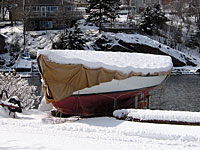
Winter storage.
Sadie sits in her cradle on the slip-way. She is leveled so that the deck and bilges drain. A frame over her deck is covered with canvas, held down by fishnet tied to the cradle.
When these boats were in use for fishing, the internal ballast was removed for hauling. The engine was removed and used for winter purposes, such as cutting wood, and the boat was overturned for storage.
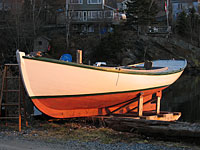
The cover comes off.
The cover comes off after the danger of a freeze is past.
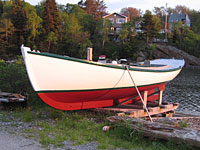
Sadie is ready for the water.
The bottom and top-sides are painted. The bilge-drain and engine cooling water sea-cock are closed. The wedges between the hull and the cradle have been removed. This allows application of bottom paint to the surfaces under the cradle braces. It also ensures that there is no pressure on the fresh paint as the cradle is lowered and moved down the slip-way. The brace from the chain-plate to the ground steadies the boat.
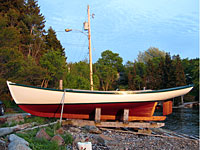
Greasing the skids.
The next step is to secure the cradle with a line to a deadman at the top of the slip-way. This is to ensure that the cradle does not move as it is lowered. Grease is applied to the bottom of the cradle, and with the help of a jack, the cradle is raised enough to remove the blocking, and then lowered to the skidway.

Down the slip-way.
At low tide, Sadie is nudged down the slipway using a steel bar. Once started, she makes her own way. The line is used to keep her from running away.
The rocks visible on the top of the skidway are part of the 1200 pounds of ballast to be added after Sadie is in the water.

Ready for the tide.
The cradle has been tied to the slip-way so that it will not float, allowing Sadie to float off as the rising water lifts her.

The kiss.
Sadie touches water for the first time in 5 months. One of the cradle tie-downs can clearly be seen here.
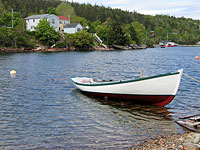
Approaching lift-off.
Before Sadie becomes buoyant, a line is run from the stern to a mooring buoy that is in line with the slip-way. Made taut, this line will pull Sadie off the cradle when she floats. The bow line is to keep her steady against any current or breeze.

Secure on the Mooring.
At the next low tide, the cradle will be hauled up the skidway and Sadie will be brought alongside the end of the slipway to receive additional ballast, her spars, and other essential gear.
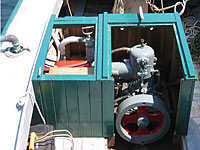
Commissioning the engine.
It takes just a few minutes to connect the water hoses, fill the grease cups, attach the battery, and oil the ignition and water pump. Open the gas line, prime the engine, grease the bearings, and she fires on the first crank. It does, however, take a few hours to paint the engine.
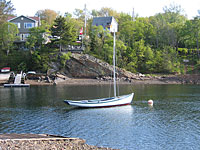
Stepping the main mast.
Sadie motors to a neighbouring wharf at low tide to step the main mast. This takes two people. One to help lift the mast vertical and steady it from the wharf; the other to guide the mast into the step.
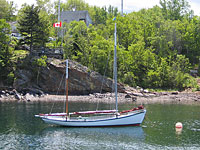
Stepping the mizzen.
The mizzen mast is short enough to be stepped from Sadie's deck. The masts have been wedged; the forestay and shrouds have been adjusted, and the sails bent on.
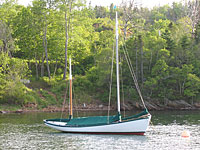
Sail covers on.
Sadie is ready for the summer. She will be hauled on the high tide in November.